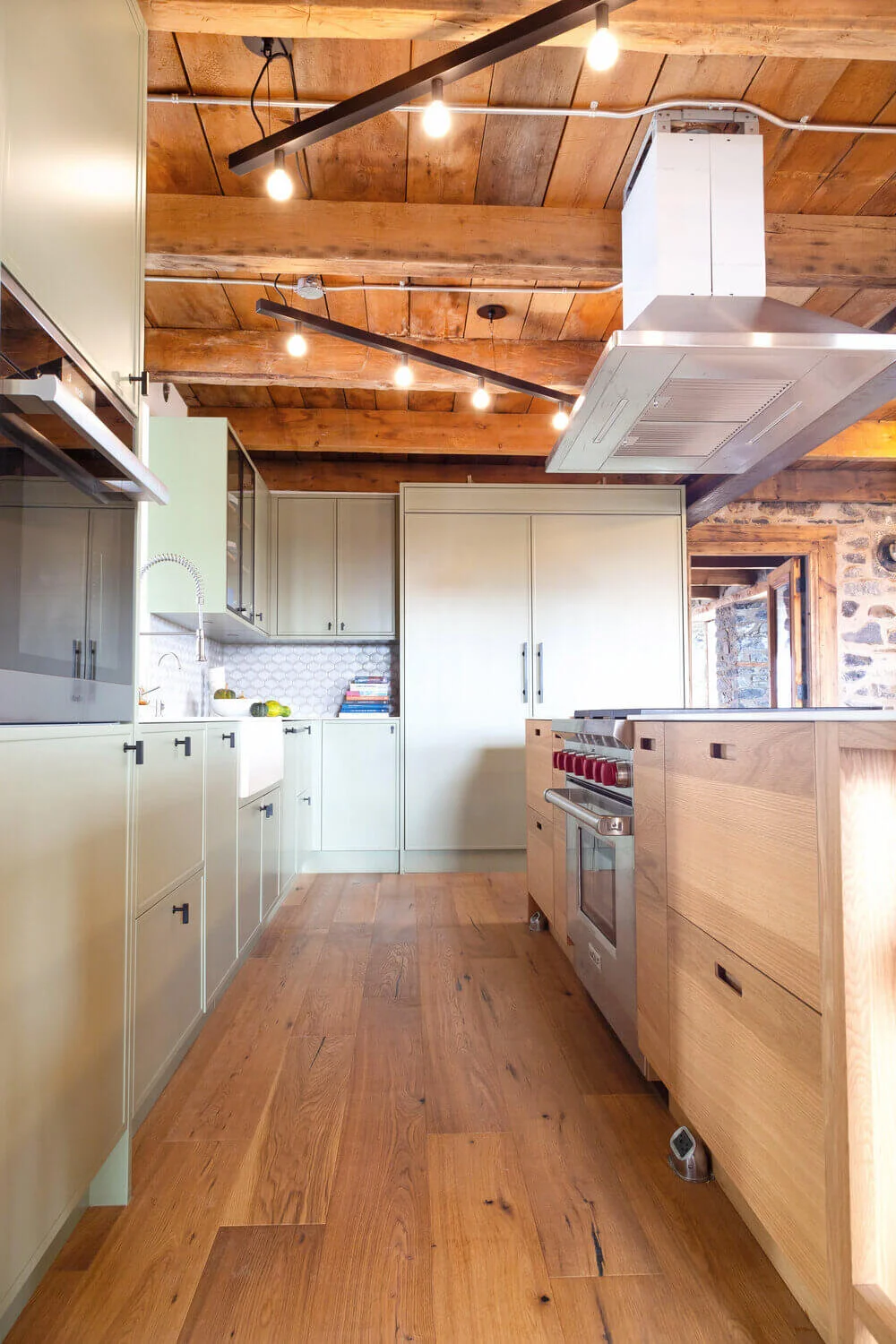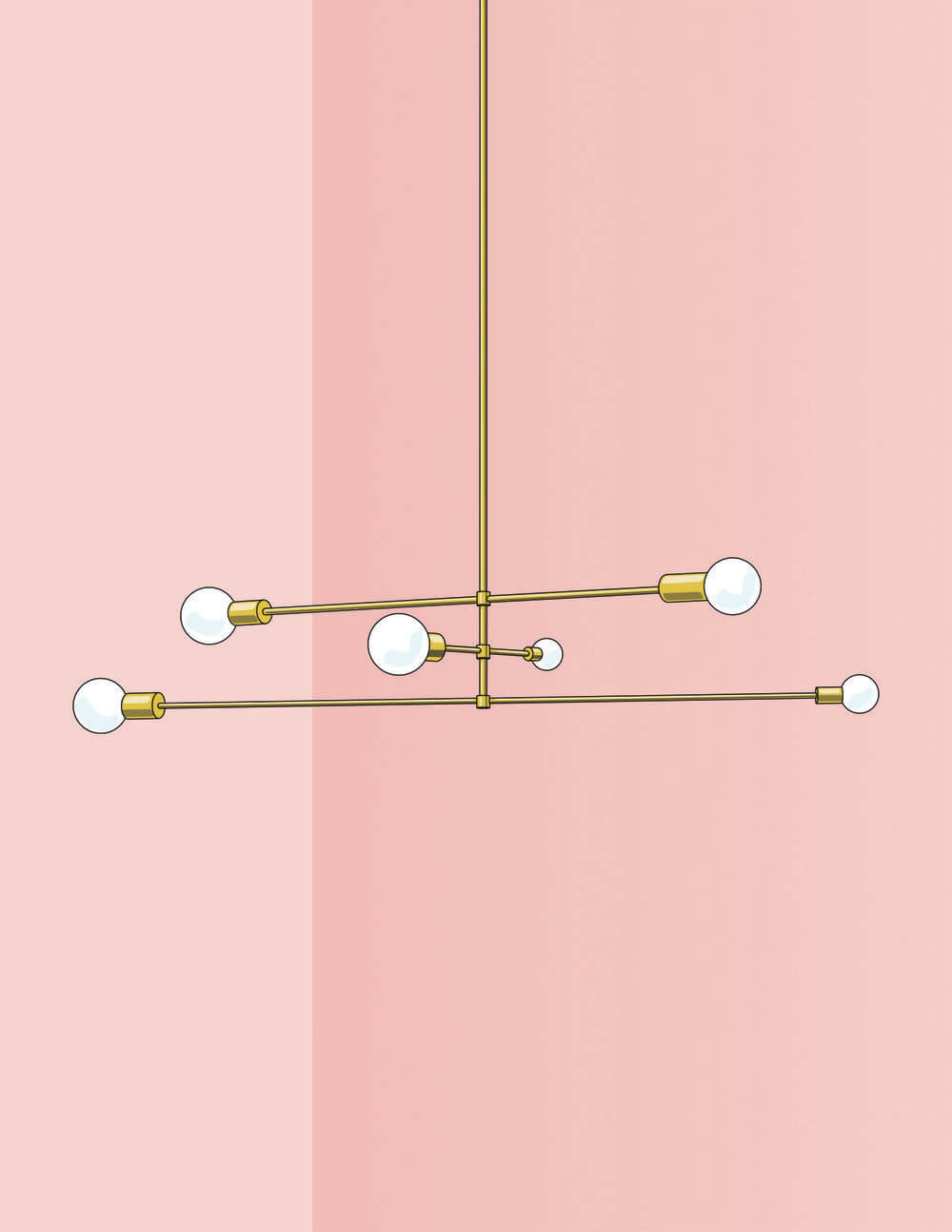LIGHTING GUIDE: 7 GOLDEN RULES TO PLAN & LIGHT YOUR KITCHEN
Photo credit: Mélanie Elliott
Lighting is an essential factor in creating a relaxing atmosphere, making the kitchen the ultimate place to relax, enjoy a drink, prepare meals, do homework, play board games or simply take the time to read a good book.
During this isolation period, we are spending more time indoors (and spending more time surrounded by artificial light). It is therefore all the more important to ensure that the lighting in our homes has a positive effect on our stress level and our general well-being.
To help you optimize this aspect that often gets overlooked, we interviewed Maude Rondeau, president of Luminaire Authentik, to get her best tips for creating a cozy atmosphere in the kitchen.
The golden rules
Here are 7 golden rules that we always follow when designing lighting plans for our clients. To illustrate these rules, let’s take the example of this lighting plan which was recently created by our designer Bianca.
Always place lighting 12 inches in front of tall elevations. This will ensure adequate lighting inside your cabinets, while highlighting materials such as wood. Example: on this lighting plan, the fridge and the pantry located in the lower right corner represent high elevations.
Don’t forget to add lighting under your cabinets! Example: on this lighting plan, LED light strips have been installed under the cabinets to appropriately illuminate the work surfaces.
Always install lighting in the centre of the island. Example: on this lighting plan, we can see 3 lights above the island; the central light is located in the very centre of the island (both horizontally and vertically) and serves as a guide for the other two lights, which are placed at equal distance from this central light.
Watch out for joists! Make sure you know your ceilings before you start planning your lighting. Since it’s not possible to install recessed lights on joists, you will be able to adjust your plan accordingly.
Multiply the light sources. These four types of lighting should be favoured in the kitchen: ambient lighting, task lighting, accent lighting and decorative lighting. The addition of several light sources will meet these four needs while creating a soothing and inviting atmosphere.
Direct the lights towards the work areas (cooking area, cleaning area and food preparation area). Example: on this lighting plan, there are suspended lights above the island (food preparation area and cleaning area), an illuminated hood (cooking area), as well as LED light strips for the other work areas. In the walk-in pantry, LED light strips will illuminate the contents of the shelves.
When there are cabinets above the counter, align the lighting with the edge of the counter. If there are no cabinets, it is possible to align the lighting in the centre of the counter. Example: on this lighting plan, the lighting in the pantry is aligned with the edge of the counter.
The main types of lighting to use in the kitchen
Before you begin, we suggest that you define your needs by dividing your lighting planning into four sections: ambient lighting, task lighting, accent lighting, and decorative lighting.
Ambient
Let’s start with an essential: ambient lighting!
“We often suggest mixing functionality and design to create a temperature, choosing recessed lights for direct lighting and linear models with glass balls for more diffused lighting. Above the island, suspensions will provide warmer lighting in the kitchen,” says Maude.
Mixing lights is key. “Using only recessed lights would make the atmosphere cold and clinical, but recessed lights work well with other types of lights. So always think about the function while aiming to create an atmosphere,” adds Maude.
In order to create an atmosphere in the kitchen, we suggest that you treat this room as if it were part of the living room. It will then integrate harmoniously with the other rooms in the house.
Task
Task lighting refers to the lighting in the cooking area, the cleaning area and the food preparation area. Precise lighting directed towards these areas will allow you to work safely while reducing eye strain. LED light strips under the cupboards, recessed lights in the pantry or above the island and hanging lights are all great options to provide adequate lighting for these areas.
When planning your lighting, make sure that the light that will illuminate your worktop will not be positioned behind you. Instead, opt for ceiling lighting; thus, you will avoid creating shadows in front of you.
Task lighting: our favourite lamp
Our founder Brigitte fell in love with the Tolomeo work lamps by Artemide, which she hangs on her counter to light up her work plan when she’s cooking—and to create a relaxing atmosphere when she’s not!
Accent
Project by Cuisines Steam including illuminated niches that display the owners’ travel memories. Photo credit: Mélanie Elliott.
Accent lighting is commonly used to direct attention to certain objects, such as works of art and collectibles. To do this, we suggest that you opt for wall lights or track lighting. In addition, if you have a glass cupboard, you can add a light inside to illuminate the contents.
This type of lighting can also be used to highlight certain features of the space. For example, our designers often use lighting to enhance certain materials, such as solid wood, or to add depth and dimension to kitchen niches.
Decorative
Project by Cuisines Steam in collaboration with Alexandre Lafleur, featuring a Luminaire Authentik light fixture. Photo credit: Mélanie Elliott.
Decorative lighting is often used in Steam kitchens to complete the look of the room. To choose the right decorative lighting, be sure to select a light that complements your space, but does not dominate it.
When it comes to kitchen island lighting, Maude always recommends using an odd number of pendant lights. As a general rule, it is also suggested to install the lights 30 to 36 inches above a counter (distance between the top of the counter and the base of the light).
Two elements that are often forgotten according to Maude
Dimmers
Opt for dimmable lights to vary the light intensity depending on the occasion—for example, by opting for a soft light to create a relaxing and cozy atmosphere during gatherings with family and friends, or by adjusting the brightness according to the seasons.
Kelvin colour temperature
The Kelvin scale is an essential tool for choosing a colour temperature. A lower Kelvin degree = warmer light, while a higher Kelvin degree = cooler light. For a warm atmosphere, we suggest that you opt for a Kelvin degree between 2500 K and 3000 K.
Locally-made lighting: our 5 favourites
Are you currently looking for lighting for your space? Here are 4 Quebec brands to discover!
Luminaire Authentik
Luminaire Authentik is a company from West Brome that designs and manufactures Scandinavian-inspired fixtures. From its workshop, the company has worked on impressive projects for the Montreal Museum of Fine Arts, Ubisoft, WeWork and several hotels such as the Fairmont The Queen Elizabeth. Click here to visit their online store!
HAMSTER
HAMSTER designs and manufactures light fixtures in Villeray—and even offers a consultation service for your custom projects! Click here to discover the lights from their classic collection, available in several heights and in two colours (brass and matte black).
Photo credit: HAMSTER
Lambert & Fils
Lambert & Fils is a Montreal-based design studio specializing in handcrafted lamps and lighting, drawing inspiration from various elements: linear suspensions (Mile collection), circles and spheres (Laurent collection), curved lines (Beaubien collection), geometric compositions combined with the rich texture of brass (Dot collection) and glass panels (Sainte Atelier collection).
Photo credit: Lambert & Fils
Photo credit: D’Armes
















